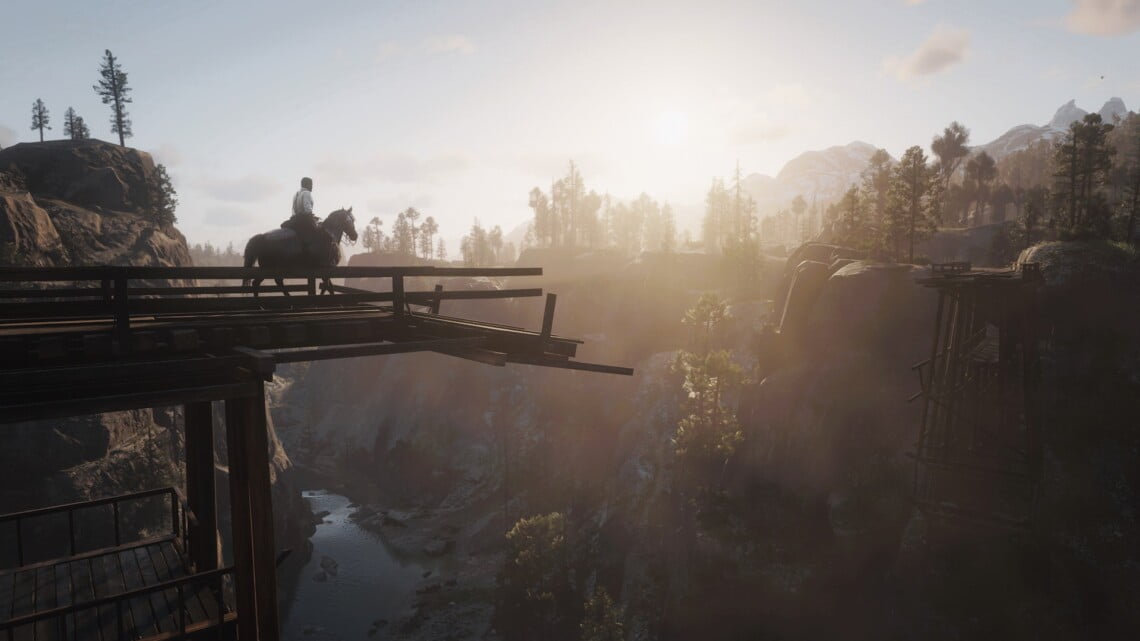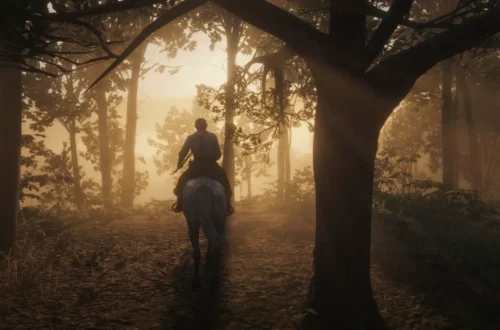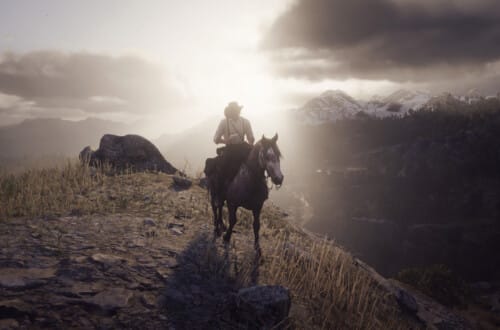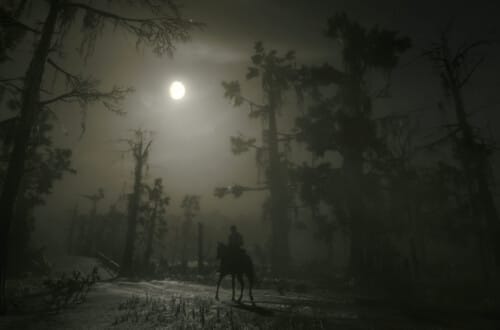Arthur Morgan’s parallels with the Son in Paradise Lost make him an improbable Christ figure.
All posts on this site feature detailed discussion of literary allusions in Red Dead Redemption 2, and as such contain unmarked major and minor spoilers for Red Dead Redemption 2, and occasionally the eventual fates of some characters in Red Dead Redemption. Read at your own risk.
One of the ways Red Dead Redemption 2 often makes literary allusions is in prophetic statements from special NPCs. Blind Man Cassidy gives Arthur Morgan one that alludes to Paradise Lost and that appears, at first blush, to be about Dutch Van der Linde and Micah Bell: “Your father is seduced by the one with the forked tongue. It’s no use hoping.” However, that isn’t the truest reading of this prophecy. Dutch is also Satan/Eve (as we’ve seen, these characters combine in Dutch) to Hosea Matthews’s Adam1. It’s Hosea who is Arthur’s truest father.
The game consistently aligns Hosea and Arthur. They dress similarly, both favoring blue, while Dutch and Micah wear red2 (in “A Fine Night of Debauchery,” Arthur will choose a blue vest and tie with his suit if his honor is high, and red vest and tie if his honor is low). Hosea and Arthur were working together while Dutch and Micah planned the Blackwater ferry job (Arthur’s journal, entries prior to Chapter 1). They both have fatal lung diseases. Hosea’s wife’s name was Bessie and the mother of Arthur’s child was named Eliza; both are versions of the name Elizabeth. Both are kind and paternal teachers to Jack. When Hosea describes himself as a young man, he sounds a lot like Arthur: “If you had anything, I’d try and take it from you. I know now, I seem like a sweet old man, but as a young man, I was worse than any of you fools. A total and absolute degenerate. A liar, a thief … a killer, when necessary” (Clemens Point). In Hosea, we see what Arthur might have become.
“The one with the forked tongue,” in its image of bifurcation, is a particularly apt way of describing Dutch. Despite the game’s ostensible claims, Arthur is not its most dualistic character: Dutch is. He sometimes helps people in need, even if his primary motivations are self-serving. He’s not incapable of caring for other people, it’s just that that caring is very shallow. His anti-racist principles – as stated, if not in praxis – are generally correct. These are the reasons Hosea, like Arthur, has fallen for “Dutch’s dumb bluster” (Arthur’s journal, entry after “Goodbye, Old Friend”). Hosea thinks he knows Dutch, and that their actions are governed by the same values. Dutch doesn’t even know Dutch — ironically, this is his greatest similarity to Arthur.
God’s Own Sons
It isn’t his only similarity: if Dutch is a little like John Milton’s God, Arthur is a little like Satan, the rebellious and charismatic son. Viewed through this lens, we can see that his jealousy over Dutch’s supposed favoritism of John is an echo of Satan’s jealousy over God’s favoritism of the Son. (This is another instance in which the game makes more sense when we consider the source material the writers are working with. After all, we never see Dutch show John much favor.) John, a man both selfish and misogynist, is much more Dutch’s son than Arthur is, just as the Son is the only one of God’s creations God deems to be much like himself. If Micah represents Satan’s worst qualities, and Dutch represents his moral complexity, Arthur is Satan at his best: although he is jealous, his rebellion is guided not by this jealousy, but by genuine concern over Dutch’s actions. In a very real sense, he never rebels at all: he remains true to the principles Dutch has always taught him, even as Dutch abandons them. When Dutch accuses Arthur of disloyalty, what he means is disobedience.
Like Hosea, Arthur is similar to Adam, but while Hosea is seduced by falsehood, Arthur’s journey is towards truth. The driving force behind Arthur’s character arc is the gaining of knowledge: about who Dutch is, about who he, himself, is. Both of those things make Dutch (in his aspect as God the Father) furious. He wants Arthur to remain his mindless and unquestioning “red right hand” (II.174). Arthur is the one who tempts himself into leaving this position — and, ironically, he’s also “tempted” to leave by Dutch, whose increasingly selfish behavior makes the baser aspects of his nature impossible to ignore.
Unlike Paradise Lost‘s condemnation of Adam and Eve, Red Dead Redemption 2 views Arthur’s transgression as a good thing. As Arthur grows more knowledgeable, he becomes a better person. The tragedy of the game is that Arthur doesn’t complete his journey of self-knowledge; he cannot forgive himself enough — for many things, but most of all for the death of his son — to attain peace.
In the Bible, God commands Abraham to sacrifice his son, Isaac. Abraham is prepared to do so, but God rescinds his order at the last moment. The command was only a test of faith. Arthur, on the other hand, lost his son Isaac. Still, the parallel is drawn: that story is so well-known in Western culture that the death of a young son named Isaac calls it immediately to mind. In Paradise Lost, after the Fall, the archangel Michael goes to comfort Adam by revealing what the future will bring. He informs him of the Son’s eventual self-sacrifice, and that his apostles will proselytize to the people:
All nations they shall teach; for from that day
Paradise Lost XII.446-450
Not only to the sons of Abraham’s loins
Salvation shall be preached, but to the sons
Of Abraham’s faith wherever through the world;
So in his seed all nations shall be blessed.
Redemption will come to Isaac’s father’s people (the Jews), whether they are his descendants or merely share his faith.
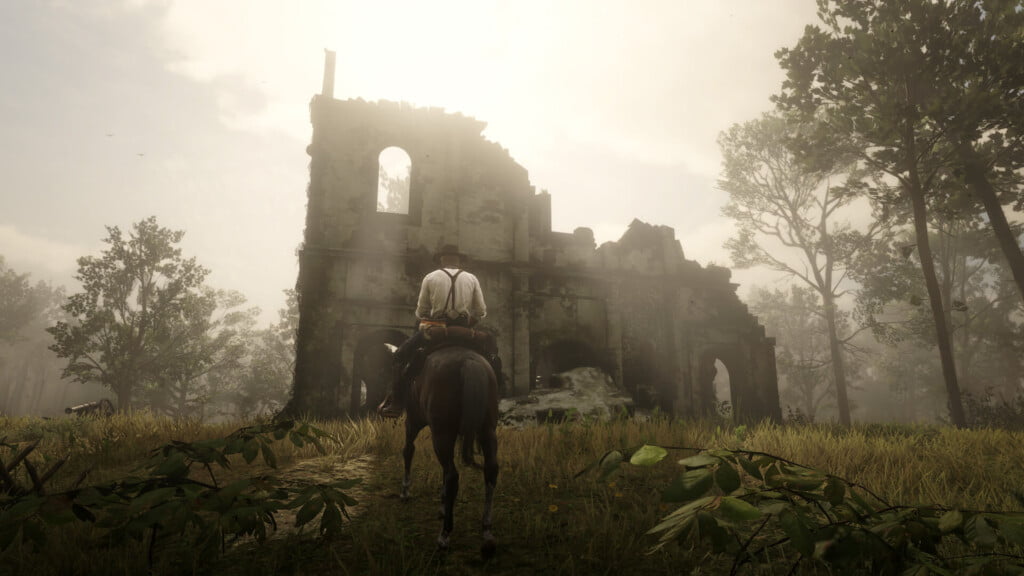
Arthur Morgan, a Christ Figure for the Apocalypse
More than any of these characters, Arthur is like the Son. Underpinning the game’s tone of bitter irony is the idea that the nasty outlaw, the murderer and thief, is a Christ figure. This may well cause cognitive dissonance, but it begins to make more sense if we consider that the game’s narrative is a sort of flattening of what we might consider the three major events of Christian mythology — original sin, Christ’s redemption, and Revelation — into one, all occurring roughly simultaneously.
Above all else, RDR2 is an apocalypse story. The world of the outlaw is ending, and all around are tales of death and destruction: whole towns are deserted; water sources are poisoned; mines stand abandoned; derelict homes slump to the earth. Livestock lie dead; the bones of creatures long extinct protrude from rock. Cemeteries and burial grounds outnumber the inhabited towns3, and that’s not even including the bodies buried in isolation. Roughly seventy bodies — not including a handful of mass graves and what are best termed decorative skulls — are strewn across the part of the map accessible during the main story alone. That so many have been left unburied tells of a world that is brutal and indifferent, but also one where something is going badly wrong. The corpses, in various states of rot or skeletonization, were people who got lost and froze to death, who were mauled by animals or brutalized by humans, who died pursuing dreams or who were crushed by despair, who starved, burned, suffocated. Worlds end, we’re reminded, all the time.
Arthur Morgan is not a Christ figure who offers salvation — as much as he tries to be — but one for the end of the world. The mission title “A New Jerusalem” alludes to the paradise that the Bible promises worthy Christians after the apocalypse, but the happiness that Arthur buys John, Abigail, and Jack is fleeting. His final journal entry has all the power of a mythological curse: “Oh Mary! be happy, please be happy. Tilly, Mary-Beth, save Karen if she ain’t too far gone. John, protect Abigail and Jack. Rains Fall — save your son as you could not save your people. Dutch, start listening to them as really loved you.” We see Mary crying at Arthur’s grave in the credits; Tilly says she believes Karen is dead; John fails to protect Abigail and Jack by going after Micah; Eagle Flies dies; Dutch never listens.
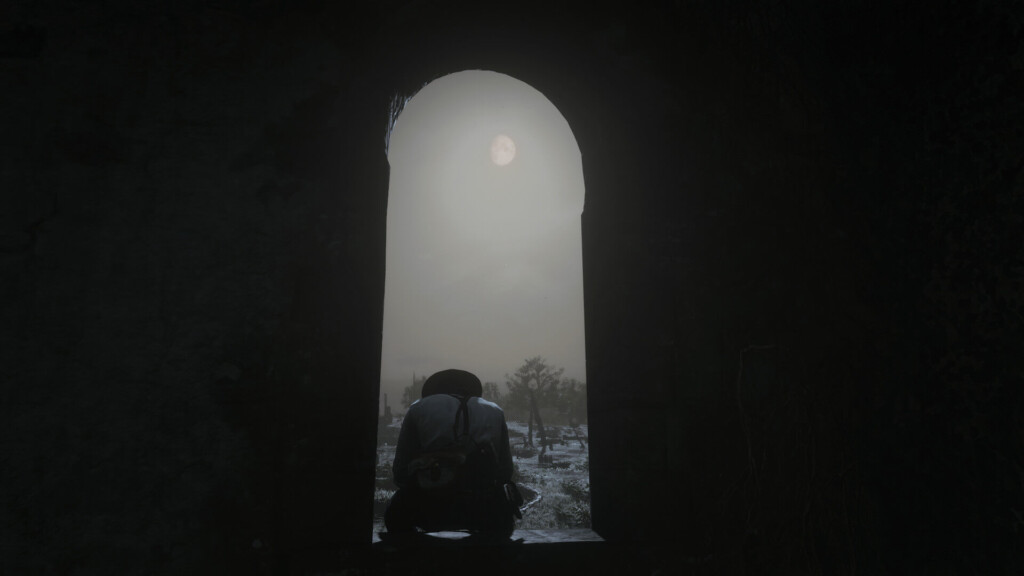
Redemption
Despite these tonal differences, we can see Arthur Morgan as a Christ figure through his parallels with the Son as Milton writes him. In Paradise Lost, after Eve and Adam eat the forbidden fruit, the Son of God, “In whom the fulness dwells of love divine” (III.225), volunteers to die – the penalty for eating of the Tree of Knowledge – when God says that mankind must perish entirely
unless for him
Paradise Lost III.210-216
Some other able, and as willing, pay
The rigid satisfaction, death for death.
Say heavenly powers, where shall we find such love,
Which of ye will be mortal to redeem
Man’s mortal crime, and just the unjust to save,
Dwells in all heaven charity so dear?
In “Of Men and Angels II,” Sister Calderón tells Arthur to “take a gamble that love exists, and do a loving act.” Saving John and his family is this loving act, and Arthur’s redemption, just as the Son saving Adam and Eve is a redeeming act of love. Arthur once contributed to Thomas Downes’s death, forcing his widow and son to leave their ranch. By saving John, he sets the story going in reverse: John, his wife, and his son acquire a ranch of their own. (Unfortunately, since Rockstar didn’t include a non-canonical ending to the main story in which John dies if Arthur leaves him, Arthur’s sacrifice doesn’t mean anything. Given the inconsistencies between the first and second games, this seems an especial waste, but typical of the bitter cynicism running through the Redemption series.)
Comforting Adam after the Fall, the archangel Michael explains how the Son will redeem Adam and Eve’s sin (a brief summary follows):
The law of God exact he shall fulfil
Paradise Lost XII.402-424
Both by obedience and by love, though love
Alone fulfil the law; thy punishment
He shall endure by coming in the flesh
To a reproachful life, and cursèd death;
Proclaiming life to all who shall believe
In his redemption, and that his obedience
Imputed becomes theirs by faith, his merits
To save them, not their own, though legal works.
For this he shall live hated, be blasphemed,
Seized on by force, judged, and to death condemned
A shameful and accurst, nailed to the cross
By his own nation, slain for bringing life;
But to the cross he nails thy enemies,
The law that is against thee, and the sins
Of all mankind, with him there crucified,
Never to hurt them more who rightly trust
In this his satisfaction; so he dies,
But soon revives, Death over him no power
Shall long usurp; ere the third dawning light
Return, the stars of morn shall see him rise
Out of his grave, fresh as the dawning light,
Thy ransom paid, which man from death redeems.
In other words, because he loves and is obedient to God, the Son will die in Adam’s place. Everyone who has faith in his act will be redeemed through this faith alone, and not due to their own good deeds. (This is Milton’s commentary on the theological argument over whether people can be saved through faith or works.) The Son will perform this redemption by taking human form, in which he’ll be persecuted and crucified. However, the Son won’t stay dead: on the third day, he’ll rise again.
Arthur, too, is betrayed “by his own nation.” Micah betrays them all; Dutch betrays Arthur, which causes Bill and Javier to do so, too. The poem goes on to describe the Son’s crucifixion. A fairly common, although not necessarily correct, theory states that victims of crucifixion often died by asphyxiation (Maslen); Arthur’s tuberculosis causes respiratory failure. Arthur Morgan sacrificing himself for John Marston is the clearest sense in which he is a Christ figure. The significance of the repeated imagery of “dawning light” is obvious to anyone who’s played through the game’s true ending, but in RDR2 it means Arthur’s death rather than a resurrection. Low-honor Arthur won’t even live to see that dawn. Interestingly, some of Arthur’s last words echo not the Son, but the Father: “I gave you all I had,” he tells Dutch. God, complaining about Adam’s disobedience, says “he had of me/All he could have” (III.97-98). Dutch, in his aspect as God, says the same thing in a bitter rant at Beaver Hollow: “I gave you all I had.” Arthur, however, is telling the truth.
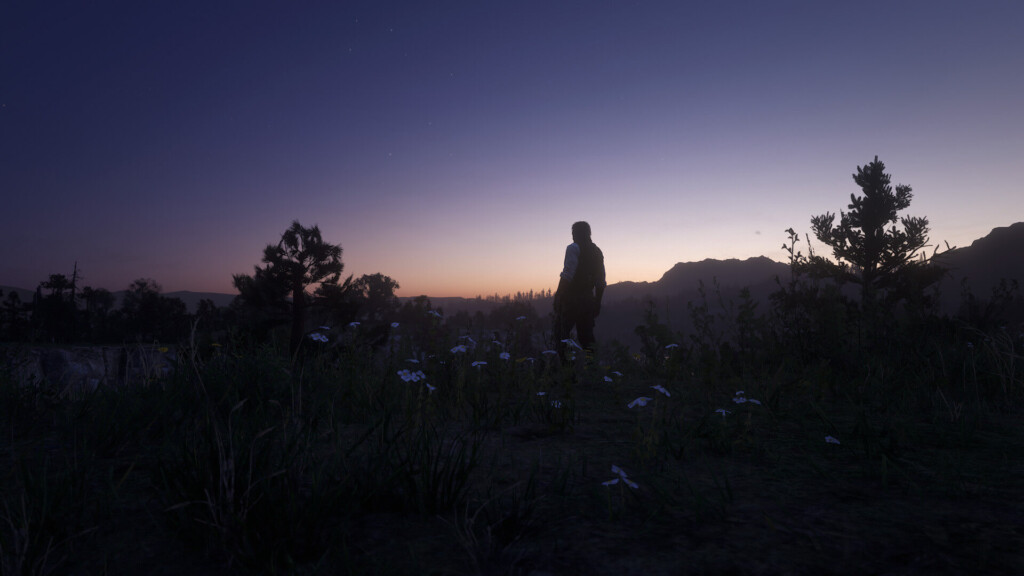
By combining the figures of Paradise Lost in ways both expected and subversive, the writers of Red Dead Redemption 2 multifaceted and compelling characters: Arthur Morgan is both a Christ figure and rebellious Satanic one. The archetypal nature of characters like Arthur, Dutch Van der Linde, and Micah Bell helps establish the semi-mythical feel of the narrative, which uses these characters to address some of the same themes the poem does: rebellion and free will, sacrifice and loss. However, as we’ve begun to see, as it explores those themes, RDR2 doesn’t always come to the conclusions that Paradise Lost does.
New here? Visit the Table of Contents to read the essays in order, or the Index to explore the site by topic. New essays are published Wednesdays at 1 p.m. E.T./10 a.m. P.T.
Sharing the site is always appreciated!
- I’ve tried to see if this prophecy is ever given after Hosea’s death. I wasn’t able to, but that doesn’t mean much either way, as this is the kind of detail Rockstar is prone to losing track of, and special NPCs don’t always appear when they should. ↩︎
- Beyond these four characters, this symbolism becomes very muddy. Leviticus Cornwall wears a blue vest and tie, for instance. This is annoying. ↩︎
- Because the major features of the epilogue part of the map already existed in Red Dead Redemption, I’m not considering them here.
Active towns, main story map (8): Valentine, Strawberry, Rhodes, Saint Denis, Van Horn, Annesberg, Butcher Creek, Wapiti.
Burial sites, main story map (18): Colter cemetery, Valentine cemetery, Emerald Ranch burial grounds, Old Tom’s Blind, cemetery south of Braithwaite Manor, Shady Belle cemetery, Rhodes cemetery, derelict cemetery SSE of Compson’s Stead, Pleasance cemetery, Saint Denis (main), Saint Denis cemetery (next to church), Van Horn cemetery, Fort Riggs burial grounds, mass worker grave south of Van Horn, Butcher Creek cemetery, Fort Brennand burial ground, Viking Burial Site, Native Burial Site. ↩︎
Bibliography
Expand to view sources.
- Houser, Dan, et al. “Red Dead Redemption II.” Rockstar Games, 2018.
- Maslen, Matthew W, and Piers D Mitchell. “Medical Theories on the Cause of Death in Crucifixion.” Journal of the Royal Society of Medicine, U.S. National Library of Medicine, Apr. 2006, www.ncbi.nlm.nih.gov/pmc/articles/PMC1420788/.
- Milton, John. The Major Works. Edited by Stephen Orgel and Jonathan Goldberg, Oxford University Press, 2008.
